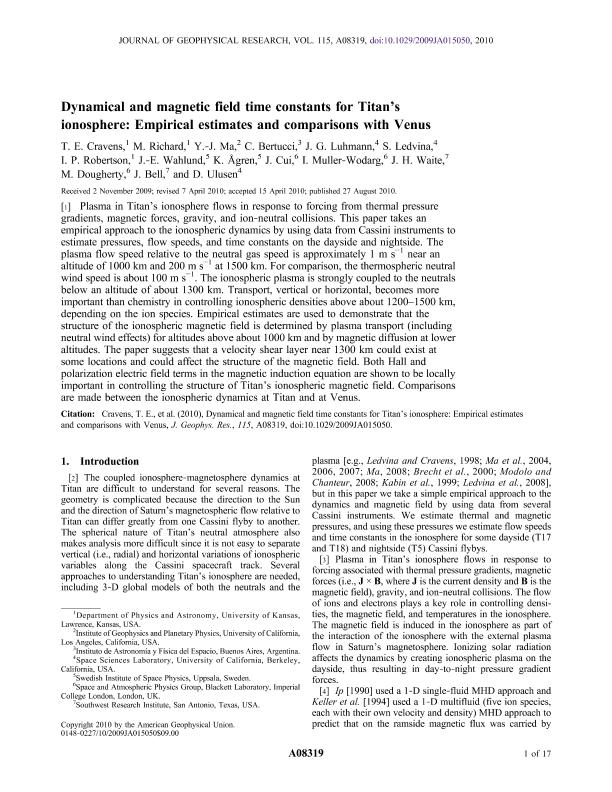Mostrar el registro sencillo del ítem
dc.contributor.author
Cravens, T. E.
dc.contributor.author
Richard, M.
dc.contributor.author
Ma, Y. J.
dc.contributor.author
Bertucci, Cesar

dc.contributor.author
Luhmann, J. G.
dc.contributor.author
Ledvina, S.
dc.contributor.author
Robertson, I. P.
dc.contributor.author
Wahlund, J. E.
dc.contributor.author
Ågren, K.
dc.contributor.author
Cui, J.
dc.contributor.author
Muller Wodarg, I.
dc.contributor.author
Waite, J. H.
dc.contributor.author
Dougherty, M.
dc.contributor.author
Bell, J.
dc.contributor.author
Ulusen, D.
dc.date.available
2017-07-13T21:11:46Z
dc.date.issued
2010-10
dc.identifier.citation
Cravens, T. E.; Richard, M.; Ma, Y. J.; Bertucci, Cesar; Luhmann, J. G.; et al.; Dynamical and magnetic field time constants for Titan's ionosphere: Empirical estimates and comparisons with Venus; American Geophysical Union; Journal of Geophysical Research; 115; A08319; 10-2010; 1-17
dc.identifier.issn
0148-0227
dc.identifier.uri
http://hdl.handle.net/11336/20436
dc.description.abstract
Plasma in Titan´s ionosphere flows in response to forcing from thermal pressure gradients, magnetic forces, gravity, and ion-neutral collisions. This paper takes an empirical approach to the ionospheric dynamics by using data from Cassini instruments to estimate pressures, flow speeds, and time constants on the dayside and nightside. The plasma flow speed relative to the neutral gas speed is approximately 1 m s<sup>‑1</sup> near an altitude of 1000 km and 200 m s<sup>‑1</sup> at 1500 km. For comparison, the thermospheric neutral wind speed is about 100 m s<sup>‑1</sup>. The ionospheric plasma is strongly coupled to the neutrals below an altitude of about 1300 km. Transport, vertical or horizontal, becomes more important than chemistry in controlling ionospheric densities above about 1200-1500 km, depending on the ion species. Empirical estimates are used to demonstrate that the structure of the ionospheric magnetic field is determined by plasma transport (including neutral wind effects) for altitudes above about 1000 km and by magnetic diffusion at lower altitudes. The paper suggests that a velocity shear layer near 1300 km could exist at some locations and could affect the structure of the magnetic field. Both Hall and polarization electric field terms in the magnetic induction equation are shown to be locally important in controlling the structure of Titan´s ionospheric magnetic field. Comparisons are made between the ionospheric dynamics at Titan and at Venus.
dc.format
application/pdf
dc.language.iso
eng
dc.publisher
American Geophysical Union

dc.rights
info:eu-repo/semantics/openAccess
dc.rights.uri
https://creativecommons.org/licenses/by-nc-sa/2.5/ar/
dc.subject
Ionosphere: Ionosphere/Magnetosphere Interactions
dc.subject
Ionosphere: Ionosphere/Atmosphere Interactions
dc.subject
Ionosphere: Ionospheric Dynamics
dc.subject
Planetary Sciences: Comets And Small Bodies: Ionospheres (2459), Planetary Sciences: Solar System Objects: Titan
dc.subject.classification
Astronomía

dc.subject.classification
Ciencias Físicas

dc.subject.classification
CIENCIAS NATURALES Y EXACTAS

dc.title
Dynamical and magnetic field time constants for Titan's ionosphere: Empirical estimates and comparisons with Venus
dc.type
info:eu-repo/semantics/article
dc.type
info:ar-repo/semantics/artículo
dc.type
info:eu-repo/semantics/publishedVersion
dc.date.updated
2017-07-13T14:03:45Z
dc.journal.volume
115
dc.journal.number
A08319
dc.journal.pagination
1-17
dc.journal.pais
Estados Unidos

dc.journal.ciudad
Nueva York
dc.description.fil
Fil: Cravens, T. E.. University of Kansas; Estados Unidos
dc.description.fil
Fil: Richard, M.. University of Kansas; Estados Unidos
dc.description.fil
Fil: Ma, Y. J.. University of California; Estados Unidos
dc.description.fil
Fil: Bertucci, Cesar. Consejo Nacional de Investigaciónes Científicas y Técnicas. Oficina de Coordinación Administrativa Ciudad Universitaria. Instituto de Astronomía y Física del Espacio. - Universidad de Buenos Aires. Facultad de Ciencias Exactas y Naturales. Instituto de Astronomía y Física del Espacio; Argentina
dc.description.fil
Fil: Luhmann, J. G.. University of California; Estados Unidos
dc.description.fil
Fil: Ledvina, S.. University of California; Estados Unidos
dc.description.fil
Fil: Robertson, I. P.. University of Kansas; Estados Unidos
dc.description.fil
Fil: Wahlund, J. E.. Swedish Institute of Space Physics; Suecia
dc.description.fil
Fil: Ågren, K.. Swedish Institute of Space Physics; Suecia
dc.description.fil
Fil: Cui, J.. Imperial College London; Reino Unido
dc.description.fil
Fil: Muller Wodarg, I.. Imperial College London; Reino Unido
dc.description.fil
Fil: Waite, J. H.. Southwest Research Institute; Estados Unidos
dc.description.fil
Fil: Dougherty, M.. Imperial College London; Reino Unido
dc.description.fil
Fil: Bell, J.. Southwest Research Institute; Estados Unidos
dc.description.fil
Fil: Ulusen, D.. University of California; Estados Unidos
dc.journal.title
Journal of Geophysical Research

dc.relation.alternativeid
info:eu-repo/semantics/altIdentifier/doi/http://dx.doi.org/10.1029/2009JA015050
dc.relation.alternativeid
info:eu-repo/semantics/altIdentifier/url/http://onlinelibrary.wiley.com/doi/10.1029/2009JA015050/abstract
Archivos asociados
